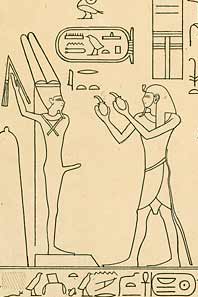Mentuhotep IV facts for kids
Quick facts for kids Mentuhotep IV |
|
|---|---|

Mentuhotep IV (right) gives offerings to Min. From Wadi Hammamat
|
|
| Pharaoh | |
| Reign | 1997–1991 BC (11th dynasty) |
| Predecessor | Mentuhotep III |
| Successor | Amenemhat I |
| Mother | Imi (King's Mother) |
| Died | 1991 BC |
Nebtawyre Mentuhotep IV was the last king of the 11th Dynasty in ancient Egypt. He ruled during the Middle Kingdom. He seems to have ruled for about seven years. Some ancient records, like the Turin Canon, mention this period but don't clearly name a king. This suggests his reign might have been a bit unclear or troubled.
Contents
Family Life
King's Mother Imi
An old stone carving in Wadi Hammamat mentions King Mentuhotep IV. It also names his mother, Imi, calling her "King's Mother." This carving only gives her that title. It does not say she was a "King's Wife" or "King's Daughter." This makes some experts think she might have been a less important wife or a concubine.
Who Was His Father?
It is not fully clear who Mentuhotep IV's father was. Most experts believe he was the son of Mentuhotep III, who was the king before him. However, some think he might have been a son of Mentuhotep II. If so, he would have been a brother or half-brother to Mentuhotep III. The fact that his name is missing from some ancient king lists suggests there might have been problems with who should become king next. His short reign, which is not well-known, also points to a time of change or trouble.
Ancient Inscriptions
Even though some king lists do not mention Mentuhotep IV, we know about him from several stone inscriptions. These carvings show how large groups of people were organized for important trips during his time as king.
Wadi el-Hudi
Mentuhotep IV is mentioned in inscriptions found at Wadi el-Hudi. These carvings are all from his first year as king.
- Wadi el-Hudi 1 (Year 1)
- Wadi el-Hudi 2 (Year 1)
- Wadi el-Hudi 3 (Year 1)
- Wadi el-Hudi 4 (Year 1)
Ain Sukhna
At the Red Sea port of Ain Sukhna, expeditions were sent to places like Wadi Maghareh in the Sinai. They brought back valuable materials like turquoise and copper. These goods were then taken to Memphis, a city about 120 kilometers away, across the desert. Or, they might have been shipped along the Red Sea coast to a port further south called Mersa Gawasis. Inscriptions from Mentuhotep IV's reign have been found there.
One inscription from his first year describes a large group:
Year 1: The king's men arrived. There were 3,000 workers. Their job was to bring back turquoise, copper, and all the good things from the desert.
Wadi Hammamat (Eastern Desert)
Mentuhotep IV is also known from several inscriptions in Wadi Hammamat. These carvings tell us about trips made to the Red Sea coast. They also record expeditions to quarry stone for royal buildings. One of these inscriptions confirms that his mother's name was King's Mother Imi.
The leader of an expedition to Wadi Hammamat in Mentuhotep IV's second year was his vizier, Amenemhat. A vizier was a very important official, like a prime minister. Many experts believe this Amenemhat later became King Amenemhat I. He was the first king of the 12th Dynasty and Mentuhotep IV's direct successor.
Here are some of the inscriptions from Wadi Hammamat:
- Hammamat G 52
- Hammamat G 53
- Hammamat G 54 (Year 2)
- Hammamat G 55
- Hammamat G 56
- Hammamat G 57 (Year 2)
- Hammamat G 58
- Hammamat G 59
- Hammamat G 60
- Hammamat G 73
- Hammamat G 140
- Hammamat M 1
- Hammamat M 40
- Hammamat M 55
- Hammamat M 105
- Hammamat M 110 (Year 2, by Vizier Amenemhat)
- Hammamat M 113 (Year 2, by Vizier Amenemhat)
- Hammamat M 191
- Hammamat M 192 (Year 2, by Vizier Amenemhat)
- Hammamat M 205 (by Vizier Amenemhat)
- Hammamat M 241
Other Discoveries
A piece of a stone bowl found at Lisht North was once thought to have the names of both Mentuhotep IV and his successor, Amenemhat I. Some believed Amenemhat I added his name to an older bowl that already had Mentuhotep IV's name. However, later research showed that Mentuhotep IV is not on the bowl. The names on it seem to belong to Mentuhotep II instead.
End of His Reign
Some Egyptologists believe that Amenemhat, Mentuhotep IV's vizier, took over the throne. This might have happened if Mentuhotep IV died without children. Or, perhaps Amenemhat simply took power. There is no clear evidence from ancient times to show that Mentuhotep was removed from power by his vizier. We also don't know if he chose Amenemhat to be the next king. Neither Mentuhotep IV's mummy nor his burial place has ever been found.
See also
- Eleventh Dynasty of Egypt family tree

